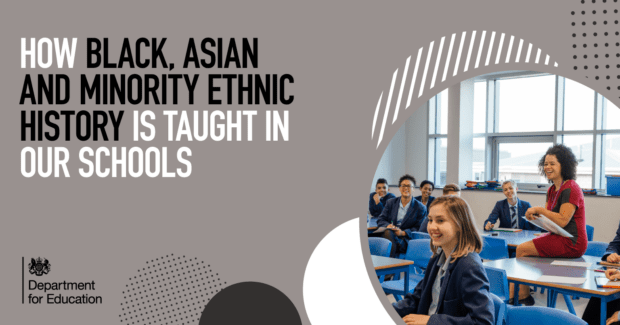
Schools play a crucial role in helping young people understand the world around them and their place within it.
The knowledge-rich curriculum in our schools offers pupils the opportunity to study significant figures from black and ethnic minority backgrounds and the contributions they have made to the nation, as well as helping them understand our shared history with countries from across the world.
Here’s how Black, Asian and Minority Ethnic History can be taught in our schools.
From at least the Roman times, Black, Asian and other Minority Ethnic people have been an integral part of Britain, and the National Curriculum supports teaching about their contribution.
One of the key aims of the history curriculum is to know and understand the history of these islands as a coherent, chronological narrative, from the earliest times to the present day. This includes how people’s lives have shaped this nation and how Britain has influenced and been influenced by the wider world, which helps build an understanding of a shared British history.
Schools can teach about how the contributions of people of all ethnicities have made this the great nation it is today.
There are a number ways that Black, Asian and Minority Ethnic history can be taught in schools using the national curriculum for history from Key Stages 1 to 3, and the subject content requirements for history GCSE at Key Stage 4:
- At Key Stage 1 the curriculum requires key historical events within or beyond living memory to be taught. This could include teaching about the lives of key Black and minority ethnic historical figures such as Mary Seacole and Rosa Parks, both of whom are used as examples in the programmes of study.
- At Key Stage 2 the curriculum requires the study of a non-European society that provides contrasts with British history, for example Benin (West Africa) from 900-1300 AD.
- At Key Stage 3there is a statutory requirement to explore ideas, political power, industry and empire in Britain between 1745-1901. This is so that every child has an understanding of the history of Empire and its consequences. Teachers could, for example, look at Britain’s transatlantic slave trade – its effects and its eventual abolition – including the successful slave-led rebellions, and challenges that led to the abolition of slavery. For example, this could include the role played by slaves and former slaves such as within the Somerset legal case and Ruling and the life and work of Olaudah Equiano in the abolition movement. This Key Stage also requires the study of an aspect of British history that consolidates and extends pupils’ chronological knowledge from before 1066. One of the suggested topics is to look at the impact of the migration of people to, from and within the British Isles.
- At Key Stage 4 (GCSE) pupils should develop and extend their knowledge and understanding of specified key events, periods and societies in local, British, and wider world history which takes in the wide diversity of human experience. Such events can include the world wars and the impact of migration on Britain. There is scope to teach Black history within these events and within the broader requirements of the GCSE subject specification.
As part of a broad and balanced curriculum, pupils should be taught about different societies, and how different groups have contributed to the development of Britain, including the voices and experience of Black, Asian and Minority Ethnic people.